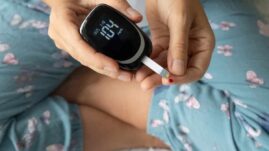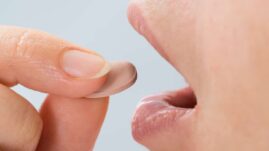More than 80% of people with prediabetes are unaware that they even have the condition!
This can be dangerous because, without intervention, most people will go on to develop type 2 diabetes in a few years.
If so many people are unaware that they have prediabetes, what signs should you be looking out for? How do you test?
This article will explain everything you need to know about the signs and symptoms of prediabetes and how to get tested for it.

Table of Contents
- What is prediabetes?
- What are the symptoms of prediabetes?
- How do you get tested for prediabetes?
- How often should you get tested for prediabetes?
- What causes prediabetes?
- Who is at risk for prediabetes?
- What do you do if you’ve been recently diagnosed with prediabetes?
- Can prediabetes come back once you reverse it?
What is prediabetes?
Prediabetes is a condition in which your body is experiencing insulin resistance, resulting in higher-than-normal blood sugar levels.
Your body is still producing insulin from the pancreas, but either you’re not making enough insulin, or your body is not using it properly.
However, your blood sugar levels are not high enough to be considered diabetic.
Prediabetes is indicated when:
- Fasting blood sugar levels are between 100-125 mg/dL
- Non-fasting blood sugar levels are between 140-199 mg/dL on a two-hour, 75-gram oral glucose test
- A1C is between 5.7-6.4%
What are the symptoms of prediabetes?
This can be tricky because, many times, prediabetes doesn’t have any symptoms at all!
This contributes to the high percentage of people who are unaware that they even have the condition.
“I was confused because I was so active. I was running an average of one to two marathons a month and doing obstacle course racing in between running. How could I have high blood sugar?
Venus Jones (read Venus’ story of reversing prediabetes)
If you are experiencing symptoms of prediabetes, they may include the following:
- Thirst
- Fatigue
- Frequent urination/polyuria
- Extreme hunger
- Dry mouth
- Fruity-smelling breath
- Blurry vision/changes to vision
- Lethargy
- Body aches
- Slow-healing wounds or infections
Contact your doctor immediately if you have been experiencing any of these symptoms for two or more weeks without explanation.
How do you get tested for prediabetes?
There are a few ways to test for prediabetes, and they all involve measuring the amount of sugar you have in your blood.
The three ways to test for prediabetes are:
- Fingerstick blood glucose test: You can find a glucometer and test strips at your local pharmacy and do this test at home to measure your blood sugar levels. You cannot eat for two hours before testing.
- A1C test: This is a blood draw done at a laboratory that measures your average blood sugar level over the previous three months. Now you can even measure your A1c at home.
- Glucose tolerance test: This measures blood sugar both before and after you drink a sweet liquid that contains fast-acting sugar. It has 75 grams of carbohydrates. You go into your local doctor’s office or lab for bloodwork before and after drinking the juice to see if your blood sugar has spiked.
How often should you get tested for prediabetes?
If you’re at high risk for developing prediabetes or diabetes, every few months, your doctor will want to check your blood sugar and perhaps even run an A1C test.
You may want to check your blood sugar more frequently at home with an at-home glucometer and test strips that you can find at your local pharmacy.
If you notice trends or changes to your blood sugars over time, especially after meals, call your doctor and inquire about an A1C test to rule out the possibility of prediabetes or diabetes.
What causes prediabetes?
There is no exact cause of prediabetes. However, many risk factors do contribute.
One of the major risk factors for developing prediabetes is insulin resistance resulting from a sedentary lifestyle and being overweight or obese, along with a genetic component (family history.)
Staying active every day and keeping your weight in a healthy range (especially abdominal fat) is the best way to prevent prediabetes.
Certain groups of people are at higher risk of developing prediabetes than others.
Read more: What Causes Prediabetes?
Who is at risk for prediabetes?
While some risk categories are in your control, others—like your family history—are outside of your control. The more groups you fall into, the higher your risk is for prediabetes.
Risk factors that you cannot control:
- You have a direct relative who has type 2 diabetes
- You are 45 years or older
- You are African-American, Hispanic, Native-American, Pacific Islander, or Asian-American
- You have Polycystic Ovary Syndrome (PCOS)
- You have Cushing’s Syndrome or Acromegaly
- You have sleep apnea
- You had gestational diabetes while pregnant
- You take steroids for a health condition, are on antipsychotic or HIV medications
The following risk factors you can control:
- You are overweight or obese
- You eat a poor diet, full of saturated fats and added sugars
- You live a sedentary lifestyle and get no regular exercise
- You have uncontrolled high blood pressure and/or high cholesterol
- You have metabolic syndrome, which is a combination of hypertension, high cholesterol levels, and a large waist measurement
- You smoke cigarettes
- You drink alcohol
Making these lifestyle changes can drastically lower your risk of developing prediabetes.
What do you do if you’ve been recently diagnosed with prediabetes?
Do not panic. Many times, prediabetes can be reversed through diet changes and exercise.
According to the CDC, if people with prediabetes lose between 5-7% of their body weight and increase physical activity to 150 minutes per week, they can often reverse their prediabetes.
The CDC-recognized National Diabetes Prevention Program (NDPP) is an evidence-based program offered in all states and covered by most insurance plans (including Medicare) that teaches the basics of reversing prediabetes.
Studies show that people who have taken the NDPP cut their risk of developing type 2 diabetes by 58% (71% for people over the age of 60.)
There are also effective medical options for treating prediabetes. You can read more about them in our article Prediabetes Medication: What are the Options?
Can prediabetes come back once you reverse it?
You are at risk of developing prediabetes again—and being at a higher risk for developing type 2 diabetes as well—if you stop exercising and maintaining a healthy diet.
This is why lifestyle changes, including diet, exercise, and sustainable weight loss, are recommended for the long-term reversal of prediabetes and prevention of type 2 diabetes.
Talk with your doctor if you have questions or concerns about your prediabetes coming back.



